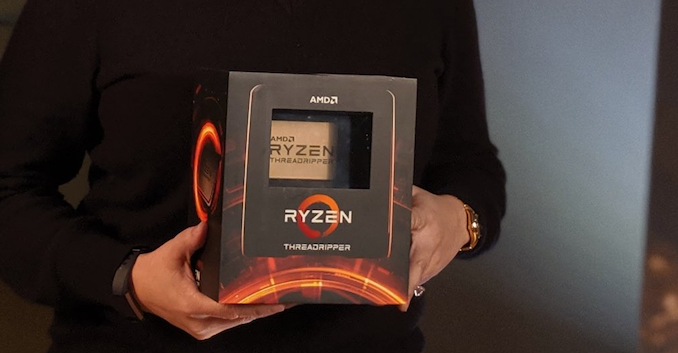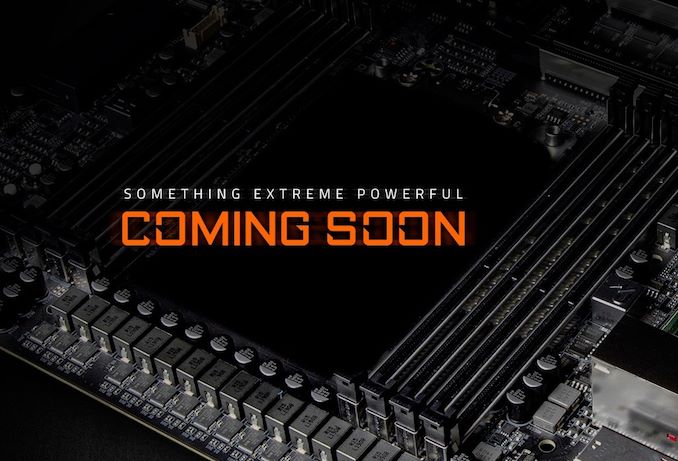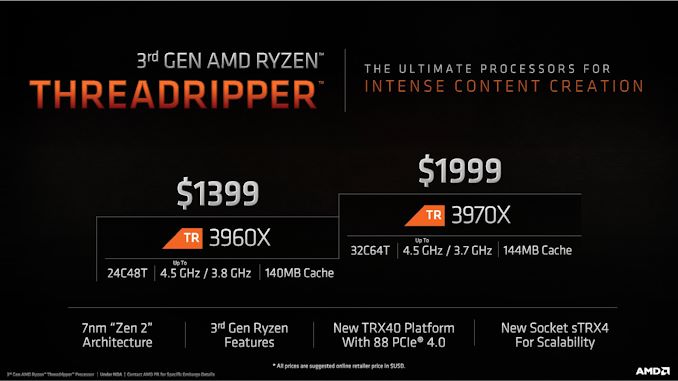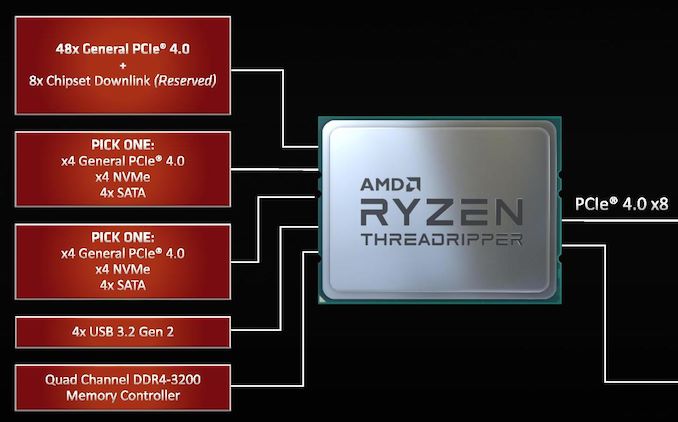AMD Q4: 16-core Ryzen 9 3950X, Threadripper Up To 32-Core 3970X, Coming November 25th
by Dr. Ian Cutress on November 7, 2019 9:00 AM EST3rd Gen Ryzen Threadripper, Up to 32-Cores
It’s the product a lot of users have been waiting for. Ever since AMD introduced the world to its Rome processors, with up to 64 cores based on 7nm chiplets and the Zen 2 microarchitecture, rumors have been swirling about what exactly the corresponding Threadripper platform will bring. We now have the answers to your questions.

From CEO Dr. Lisa Su's Twitter
The two processors that AMD will be initially launching in the 3rd Generation Ryzen Threadripper family are the TR 3960X and the TR 3970X. These are 24-core and 32-core parts respectively, built using four chiplets and one IO die in a Rome-sized package. Both CPUs will feature a 280 W TDP, and offer boost frequencies up to 4.5 GHz.
| AMD HEDT SKUs | |||||||
| Cores/ Threads |
Base/ Turbo |
L3 | DRAM 1DPC |
PCIe | TDP | SRP | |
| Third Generation Threadripper | |||||||
| TR 3970X | 32 / 64 | 3.7 / 4.5 | 128 MB | 4x3200 | 64 | 280 W | $1999 |
| TR 3960X | 24 / 48 | 3.8 / 4.5 | 128 MB | 4x3200 | 64 | 280 W | $1399 |
| Second Generation Threadripper | |||||||
| TR 2990WX | 32 / 64 | 3.0 / 4.2 | 64 MB | 4x2933 | 64 | 250 W | $1799 |
| TR 2970WX | 24 / 48 | 3.0 / 4.2 | 64 MB | 4x2933 | 64 | 250 W | $1299 |
| TR 2950X | 16 / 32 | 3.5 / 4.4 | 32 MB | 4x2933 | 64 | 180 W | $899 |
| TR 2920X | 12 / 24 | 3.5 / 4.3 | 32 MB | 4x2933 | 64 | 180 W | $649 |
| Ryzen 9 3950X | 16 / 32 | 3.5 / 4.7 | 32 MB | 2x3200 | 24 | 105 W | $749 |
There’s a lot to unpack here.
The 32-core TR 3970X has 64 threads, a base frequency of 3.7 GHz, a turbo frequency of 4.5 GHz, comes with 64 PCIe 4.0 lanes, four memory channels of DDR4-3200 (1DPC), and will retail at $2000. To put that in perspective, it wasn’t too long ago that for that money you would only get 10 cores.
The 24-core TR 3960X offers almost the same, but trades a few cores for a 3.8 GHz base frequency and will retail for $1399. The competition for this part is likely to be the Core i9-10980XE, which has 18-cores and has a tray price of $979.
Both CPUs have 128 MB of L3 cache, due to the use of four chiplets. We asked AMD if these CPUs have 4 chiplets inside the package and 4 dummy ones, like the dummy silicon in previous Threadripper products – AMD confirmed that there will only be four chiplets in each package. This means that each CPU will be in a symmetrical 6+6+6+6 or 8+8+8+8 configuration, minimizing the total amount of silicon AMD has to ship.
Each CPU supports four channels of DDR4-3200. We confirmed that this included support for ECC UDIMMs on a board-by-board basis, but does not include RDIMM or LRDIMM support. AMD did state that these new CPUs are validated for the 32 GB DDR4 modules coming onto the market, which makes a realistic maximum DRAM support of 256GB (8 x 32GB).
For performance, AMD gave us some numbers comparing each CPU to the 18-core Core i9-9980XE from Intel. In common workstation tasks, such as program compilation, Adobe Premier transcoding, and rendering, AMD is quoting a +22-31% performance gain for the 24-core part, and a +36-49% uplift for the 32-core part.
When we asked AMD about AI performance, they stated that while AI is an emerging workload in the enterprise space, for the workstation market these products are targeting exactly what their customers are requesting today: ‘Threadripper and Zen 2 have been taken by customers looking at content creation, CAD, and code work/compilation. AI is still an emerging vertical in the workstation at this time.’
Compared to previous generation Threadripper parts, the new 3rd Gen Ryzen Threadripper features a central I/O die in the hardware which all the chiplets are connected to. This I/O die has all the PCIe lanes and the DRAM channels, which means that the memory latency issues with the 1st/2nd Generation Threadripper should no longer be present with the new chips. Both chips launched here have 64 PCIe 4.0 lanes, which are split into 48x general purpose lanes, 8 lanes for the CPU-to-chipset communications, and 8 lanes for I/O. This means that users can have the following CPU configurations:
- 1st root complex: x16 or x8/x8
- 2nd root complex: x16 or x8/x8
- 3rd root complex: x16 or x8/x8
- Chipset downlink: x8
- Pick one: PCIe 4.0 x4 slot, 1 x NVMe PCIe 4.0 x4, 4x SATA
- Pick one: PCIe 4.0 x4 slot, 1 x NVMe PCIe 4.0 x4, 4x SATA
Obviously things like SATA ports can also come off the chipset. We discuss the new chipset on the next page. But one thing to note here is the CPU-to-chipset connection.
For AMD Ryzen on most AM4 chipsets, for first generation and second generation Threadripper, and for every Intel platform in recent memory, the connection between the CPU and the chipset has been the equivalent of a PCIe 3.0 x4 link. This link, as the industry has progressed into the world of NVMe storage, has become a bottleneck for any user wishing to push a modern PCIe-based storage drive along with anything else on the same uplink. AMD increased it for the X570 motherboard generation to PCIe 4.0 x4 for mainstream, doubling the bandwidth from its closest competitor, but what AMD is doing with the new 3rd Gen Threadripper is increasing that link bandwidth by a factor of two again.
With this CPU, and the TRX40 chipset, users now have a PCIe 4.0 x8 link between the CPU and the chipset. This is the equivalent of a PCIe 3.0 x16 link, or a previous generation full GPU slot. It means that users could, if they wanted, push four times as much data up and down that link. To be honest, this sort of thing should have happened a while go on the Intel side of the equation, so I’m glad that AMD is pushing the boundaries here. It’s also one reason for 3rd Gen Threadripper having a new socket.

From GIGABYTE's Aorus Facebook Page
Yes, you read that correctly: the new Threadripper requires a new socket. Because of the new CPU-to-chipset link, as well as a few ‘forward looking adjustments and scalability’, we now have what AMD are calling an sTRX4 socket and related TRX40 motherboards. AMD wasn’t prepared to make a statement on the record about committing to this socket long term, but stated that adjustments were made to ensure the future longevity of the platform, so one could infer at least one more generation on this new socket. Technically it is the same 4094 pins as the previous socket, and even the keying (the marks along the side of the processor) is the same, however AMD stated that due to this new PCIe 4.0 x8 requirement, if you put a new processor in an old motherboard (or vice versa), it just won’t work.
As for the motherboards, expect a few new parts to enter the market. More details on TRX40 on the next page.
But motherboards aside, I just want to point out that AMD's numbering scheme leaves some room at the top. Above the 3970X, there leaves the potential for a 3980X and 3990X. We know that these CPUs are based on the same layouts as AMD's Rome-based EPYC processors, and those are offered with 48-core and 64-core variants. We may be at a practical TDP limit of 280W, but if there's more room at the top, AMD might take it. At this point, AMD has said that they are only announcing two SKUs today and declined to answer the question of whether any more are coming.
| AMD HEDT SKUs | |||||||
| Cores/ Threads |
Base/ Turbo |
L3 | DRAM 1DPC |
PCIe | TDP | SRP | |
| Third Generation Threadripper | |||||||
| TR3970X + 20 ? | There's some space here for more SKUs | ||||||
| TR3970X + 10 ? | |||||||
| TR 3970X | 32 / 64 | 3.7 / 4.5 | 128 MB | 4x3200 | 64 | 280 W | $1999 |
| TR 3960X | 24 / 48 | 3.8 / 4.5 | 128 MB | 4x3200 | 64 | 280 W | $1399 |












171 Comments
View All Comments
cfenton - Thursday, November 7, 2019 - link
Almost nothing. These things are for work. A reasonably fast quad core (anything Ivy Bridge or newer, really) is fine for almost any casual programs. Going up to eight cores makes sense for gaming since the new consoles will be eight core.TheinsanegamerN - Thursday, November 7, 2019 - link
The consoles have been 8 core since 2013 dude. PS4 and xbone are 8 core. 8 slow cores, which should have prompted swift acceleration of multi threaded game engines.Yet here we are.
milkywayer - Thursday, November 7, 2019 - link
Half of this console generation Intel was in the lead and they kept milking the core count. Until 3,4 years ago they were selling dual core cpu as i7 on mobile. It wasn't until AMD came up and basically showered everyone with 4 and 6 core cpus for half the price is when Intel dropped the BS and started offering real 6 core cpus in the lower tier consumer market and 4 core real 4 core cpus in mobile etc. I blame only Intel.cfenton - Thursday, November 7, 2019 - link
And we saw slow progress toward multi-threaded games throughout the generation. There are way more games today that can take advantage of 4+ cores than there were in 2013. It takes time to adapt game engines and not every kind of game will even benefit from more cores. All I'm suggesting is that if you play games you have some reason to go beyond four cores.evernessince - Thursday, November 7, 2019 - link
Consoles were based off jaguar, which really had 8 half cores that shared execution units. So really, 4 cores.scineram - Friday, November 8, 2019 - link
No.Spunjji - Friday, November 8, 2019 - link
You're confusing Jaguar for Bulldozer.Jaguar uses complete cores, albeit "small" ones in terms of area - in design and performance terms they're somewhere between the old K8 Athlon 64 and K10 Athlon II processors.
I think the confusion comes in because the console implementation of Jaguar has 8 cores split across 2 "modules" which is the same terminology used for 'dozer, but referring to a different thing:
Bulldozer module = 2 cores with shared FP resources
Jaguar module = 4 independent cores, like a CCX in Zen
Zizy - Friday, November 8, 2019 - link
8 cores at 1.6GHz (PS4 as the slowest) is at best the same as 4 cores at 3.2 GHz, assuming everything else equal and perfect MT. Plus those cat cores were essentially half as capable as the current stuff, normalized by clock. Therefore, consoles have about the same as 2 proper desktop cores - the lowest end CPUs you can buy.Anyway, there are many games that use more than 4 cores these days. Especially stuff coming out now when also Intel started offering more cores and AMD having competitive if not superior chips.
nevcairiel - Thursday, November 7, 2019 - link
Casual everyday users absolutely do not need such CPUs.DigitalFreak - Thursday, November 7, 2019 - link
Exactly right. Core count is the new Mhz race for the uninformed.